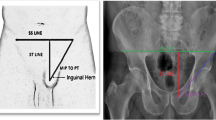Abstract
In 33 inguinal regions, we determined the anthropometric characteristics of the pubic arch and the anatomic structures of the suprainguinal space and assessed whether there is a relationship between anatomic features and function of the defense mechanisms. There was a low position of the pubic arch (pubic tubercle and interspinal line distance >75 mm) in 23 cases. The low-pubic-arch group showed a significantly longer inguinal ligament and a greater angle made by the superior border of the suprainguinal space and the inguinal ligament at its medial insertion. The position of the pubic arch correlated significantly with the diameter of the internal ring, the length of the inguinal ligament, and the angle made by the superior border of the suprainguinal space and the medial insertion of the inguinal ligament. A low pubic arch would represent an unfavorable condition for an adequate function of the anatomic defense mechanism against hernia.





Similar content being viewed by others
References
Abrahamson J (2001) Mechanisms of hernia formation. In: Bendavid R, Abrahamson J, Arregui ME, Flament JB, Phillips EH (eds) Abdominal wall hernias: Principles and Management. Springer-Verlag, New York, pp 133–137
Fruchaud H (1953) The effect of the upright position proper to man upon the anatomy of the inguinal region: surgical consequences; anatomic bases of surgical treatment of inguinal hernia [Article in French]. Mem Acad Chir (Paris) 63:652–661
Keith A (1923) On the origin and nature of hernia. Br J Surg 11:455–475
Lytle WJ (1945) The internal inguinal ring. Br J Surg 128:441–446
Ajmani ML, Ajmani K (1983) The anatomical basis for the inguinal hernia. Anat Anz 153:245–248
Zimmermann LM, Anson BJ (1967) Anatomy and surgery of hernia. 2nd edition. Williams & Wilkins, Baltimore, pp 136–140
Zinanovic S (1968) The anatomical basis for the high frequency of the inguinal and femoral hernia in Uganda. East Afr Med J 45:41–46
Ledinsky M, Matejčić A, De Syo D, Doko M (1998) Some structural characteristics of the inguinal region in the Northern Croatia. Coll Antropol 22:515–524
Abdalla RZ, Mittelstaedt WE (2001) The importance of the Hessert’s triangle in the etiology of inguinal hernia. Hernia 5:119–123
McArdle G (1997) Is inguinal hernia a defect in human evolution and would this insight improve concepts for methods of surgical repair? Clin Anat 10:47–55
Avisse C, Delattre JF, Flament JB (2000) The inguinal ring. Surg Clin North Am 80:49–69
Ponka JL (1980) Hernias of the abdominal wall. Philadelphia, W.B. Saunders, pp 82–89
Harris FI, White AS (1937) The length of the inguinal ligament in the differentiation between direct and indirect inguinal hernia. JAMA 109:1900–1903
Ferraz de Carvalho CC, Souza RR, Fernandes PMP, Waksman H, Fernandes VC (1987) The relationship between anthropometric parameters and measurements of the human inguinal region. Surg Radiol Anat 9:281:285
Peri G, Farina F, Marcianó V, Ridola C, Diana G, Arcara M, Guercio G, Sommariva V (1996) Clinical and anatomic features of the inguinal canal during hernia. Ital J Anat Embryol 101:69–80
Acknowledgments
We thank Marta Pulido, M.D., for editing the manuscript and for editorial assistance.
Author information
Authors and Affiliations
Corresponding author
Rights and permissions
About this article
Cite this article
López-Cano, M., Munhequete, E.G., Hermosilla-Pérez, E. et al. Anthropometric characteristics of the pubic arch and proper function of the defense mechanisms against hernia formation. Hernia 9, 56–61 (2005). https://doi.org/10.1007/s10029-004-0282-x
Received:
Accepted:
Published:
Issue Date:
DOI: https://doi.org/10.1007/s10029-004-0282-x




